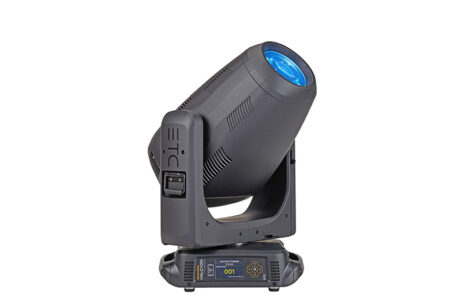
High End Systems has a storied product line-up. They were one of the first companies to produce their own dichroic filters in the U.S., and one of the first to release a hard-edged LED fixture. Since their acquisition by ETC in 2017, they haven’t slowed down, and, like many other manufacturers in the first quarter of the 21st century, have transitioned fully to LED. This month we’re looking at the next generation of LED profile fixtures from High End Systems, the Halcyon Titanium.
Versions, Light Engine
The Titanium is the middle child in the Halcyon lineup—which also includes a smaller Gold version and a bigger Platinum version. Each of the Halcyons are available in two versions—‘High Fidelity’ and ‘Ultra Bright.’ The High Fidelity (HF) version, which I tested, is dedicated especially to the faithful reproduction of colors. The Ultra-Bright (UB) version sacrifices some color fidelity for brightness in cases where that’s more desirable. The Halcyon Titanium in HF Mode outputs 24,000 Lumens and in UB Mode outputs 40,000 Lumens.
Powered by a very custom 600W white LED engine made by YLX, the Titanium outputs a brilliant field of white light with a CCT of 5,800K. I measured 6,355 lux from a distance of five meters at 50% zoom after letting everything come up to temperature. This is down from an initial value of around 7,100 lux, an output loss of around 10%, which is in line with the numbers I see on most LED fixtures these days.
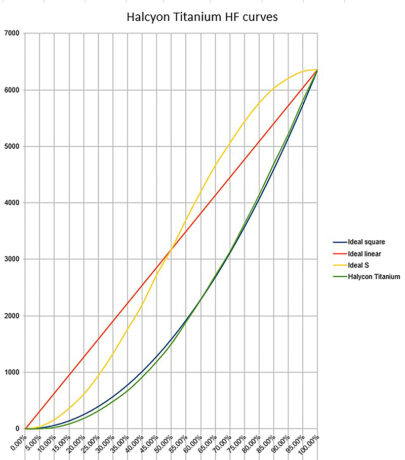
Dimming
The dimming curve is, simply put, nearly perfect; I have little doubt in the ability of ETC and High End Systems to make a stellar LED dimmer, as they have here. I tested the square law curve, which is almost exactly matched to a mathematically ideal curve. ETC publishes the TM-30 values for their engine, which show a Fidelity Index (Rf) of 91, and a Gamut Index of 98. These are excellent values. The default Pulse Width Modulation (PWM) is set to a very high 16 kHz, virtually guaranteeing no issues with camera flickering at the minor expense of some dimming smoothness, but the user can select a 2.4 kHz PWM frequency to get smoother performance. Good low-end dimming at higher PWM frequencies is technically challenging, and the results continue to improve thanks to hardware advancements. Here’s a short aside—this is something I think more lighting people ought to be aware of. Adjusting your PWM frequency to be higher reduces the number of bits available to allocate to dimming, so it’s not just a matter of setting the PWM in your LED fixtures as high as it will go; the best PWM is dependent on your use case.
Cooling and Noise Levels
By default, the fixture automatically adjusts its fan speed, and it is nearly silent when not outputting light. This setting can be overridden both by DMX and by Studio Mode, which keeps the fans quieter at the cost of some light output. The fixture is quite dynamic in its adjustment, and I could hear it ramping up and down as I inserted gobos and shutters into the beam. The fans can also be adjusted directly via DMX; if you have a cue or a scene you need the fans to be silent on, this is easily accomplished.
Color Mixing
First in line past the LED engine is the color mixing module, which uses opposing flags that open and close like a pair of curtains across the beam. The colors chosen were nicely saturated, though—and this is absolutely subjective—the yellow is a touch chrome-y for my tastes. Your mileage may vary. A variable CTO flag on this module gradually adjusts the CCT down to 2,200K. In general, I found the color mix to be smooth and even across the beam, though very narrow zooms or extremes of focus obviously present a challenge to nearly every fixture in this regard.
A fixed color wheel rides above on the gobo module, with six color positions plus open, glued into interchangeable holders on the wheel. One slot is taken up by a TM-30 filter, which I’m not sure is warranted on the High Fidelity version that I tested—I would have appreciated a deep green instead, which as a mixed color nearly always eats up a ton of light. The other colors are expected, such as a deep red, and nicely round out the color mix. Adjacent filters are very close together without much of a noticeable gap, which helps create some nice split colors and should be useful for effects.
Gobos, Animation, Iris
Past the color mix module lies the gobo module, with two identical indexing and rotating wheels, each with seven positions plus open. These ride in a familiar carriage system and can be easily swapped by the user. I found the pattern artwork to be very usable, geared mostly toward aerial projection but with several patterns that could also work projected onto scenery. It’s an attractive-looking and versatile gobo load. The fixture automatically inserts the CTB filter whenever there’s a gobo inserted to counteract the color temperature drop introduced by the gobo. Center-to-edge focus was essentially perfect, something that other lights struggle to get right due to the LED arrays being slightly convex. I also found I could defocus the gobos without getting optical “ghosts” of the LED array.
This module also holds the animation wheel, with a large radial breakup pattern that makes for nice “organic” effects and features variable angle of insertion. There’s also a channel that allows the user to do chases and animations across the actual LED array itself, which adds an additional layer of motion. A 16-blade iris allows beam diameter reduction.
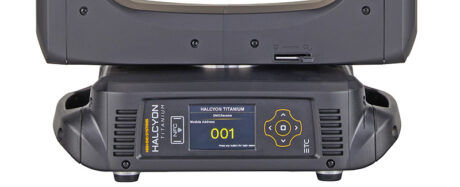
Framing Shutters, Diffusion, and Prisms
Further up in line is the framing shutter module, which features four full-curtain shutters, on four separate planes. Each one moves quite quickly and precisely, with the whole module rotating ±90° in either direction. Past this module are the frost filters, of which there are three: light, medium, and heavy. All three act as contrast reducers until fully inserted, then act with increasing levels of diffusion, the final one being a quite heavy frost that acts as a wash effect. The Trifusion channel allows the programmer to use all three of these frost filters as one channel, with the fixture crossfading between them, or they can be controlled independently.
Two prisms are included, a five-facet circular prism and a four-facet linear prism, which can be used at the same time. Both have good image separation and are indexing and rotating. Zoom is from 6° to 60°, and the prism insert points overlap part of the zoom range, so be aware of that when programming.
Pan and tilt ranges are 542° and 258°, and I measured full-range motions in 2.6s and 1.6s, respectively. Pan and tilt were extremely smooth in slow moves, with no noticeable judder. Power in is via Neutrik powerCON TRUE1 inputs and pass-throughs, while control is via 5-pin DMX or etherCON inputs and pass-throughs for direct Art-Net or sACN. The Halcyon has a very user-friendly menu system, and the capability to set addresses and other options through Near-Field Communication (NFC) via an ETC phone app. Homing took ~56s and was well-behaved in resets. Another interesting note: the fixture does not do a standard “full move” reset, instead relying on absolute positional sensors to home itself, very quietly and with minimal exterior movement, a feature that might be especially pleasing in situations where the audience has a clear view of the lighting rig. Rigging is via standard omega-style brackets.
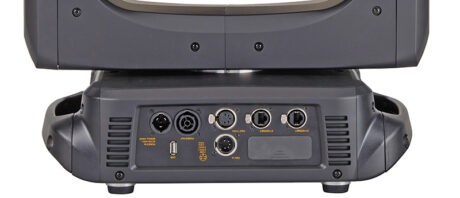
At a Glance:
Quiet and Impressive
The High End Systems Halcyon Titanium HF is a strong middle addition to the Halcyon range. With its quiet and subtle homing process, impressive quality of light, and multitude of features, the Titanium would be an excellent addition to midsize events, houses of worship, or theatrical venues of every sort.
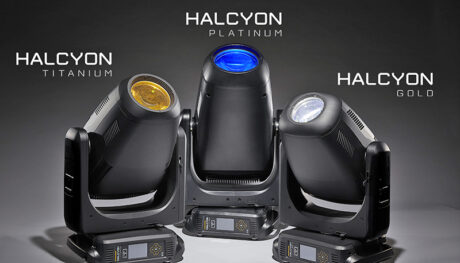
Halcyon Titanium HF
PROS
- Excellent quality of light
- Absolute positioning makes for unobtrusive homing
- Sound-conscious design
CONS
- Lacks a fixed primary green filter
- Mixed red was slightly orange
SPECS
- Light Source: 600W High Fidelity LED Engine; 5,800K
- Output: 24,000 Lumens, 93+ CRI
- Zoom: 6° – 60°
- Range: Pan – 542°, Tilt – 258°
- Input Range: 100-240V, 50/60Hz
- Power Draw (Std/Max/Standby): 960W/1,126W/31W
- Color Mixing: CMY/CTO
- Color Temperature: Variable to 2,200K
- Color Wheel: 6 Colors
- Rotating Gobos: 7 + 7
- Framing: Full Curtain w/ 180° Rotation
- Iris: 16-Blade
- Animation: Rotating with Incline Control and LED Animation
- Frost: Trifusion (3 Levels of Frost)
- Prism: 5-Facet Star + 4-Facet Linear Rotating
- Dimming: 16-bit, DMX Controlled
- Control: DMX via RS-485, Art-Net, sACN, RDM; 60 DMX Channels
- On-Board Control: Full-Color Graphical UI with Touch Screen and 5-Button Navigational Control; NFC Configuration
- Connectors: Neutrik® powerCON® TRUE1 In/Out; XLR5 In/Thru; 2 Ethernet; 1 USB
- Operating Temp: 14° to 104°F (-10° to 40°C)
- IP Rating: IP20
- Dimensions: 28.4” H x 18” W x 11” D
- Weight: 76 lbs.
- Warranty: 5 Years for Light Engine; 2 Years for Complete Fixture
MANUFACTURER: ETC / High End Systems
More Info: www.etcconnect.com/Halcyon/


